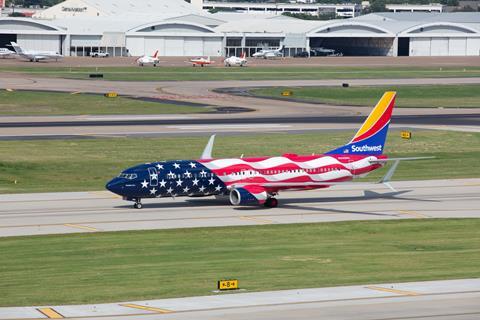Southwest Airlines is “very delighted” with the post-coronavirus crisis rebound in air travel and has not yet seen any indication that the more-contagious “Delta variant” has had any effect on business.
The Dallas-based airline says on 22 July that it reached a profit of $348 million for the second quarter of the year, supported by the government’s payroll support plan (PSP). Without the aid, the airline would have posted a loss of $206 million.
The airline said it had revenue of $4 billion, up from $1 billion in the year-ago quarter. But, the revenue figure was still 32% lower than in the same quarter in 2019, prior to the pandemic.

The second quarter, which ended on 30 June, “marked an important milestone in the pandemic recovery as leisure travel demand surged”, says Southwest chief executive Gary Kelly.
“We generated net income in June 2021, representing our first monthly profit without taking into account the benefit of temporary salaries and wages cost relief provided by PSP proceeds, since the negative effects of the pandemic began in March 2020,” he adds.
DELTA VARIANT
The new “delta variant” of the coronavirus, which is more contagious and spreading rapidly across the USA, has not made any notable impact on bookings, executives say. The effect of the variant, Kelly says has so far been “statistically insignificant”. He adds that the airline has a “solid foundation” of bookings into September.
“Booking and revenue trends are even better than in June, and better than the second quarter as a whole,” Kelly says. “We are very well prepared to manage and muddle our way through if the delta variant affects our business.”
“Folks are trying to stay informed, the case counts have ticked up,” he says. “[But] there’s no indication anywhere that activity is being diminished because of an increase in the case counts.”
While the airline is soaking up the leisure travel rebound, corporate travel remains depressed, but is also returning, executives say.
Whereas that segment was down 88% in the first quarter of 2021, the airline saw significant and sequential improvement in the following months. In May, executives say it was 77% below 2019 levels, and in June it ticked up to being 69% below those levels.
“Business travel [will reach] 50% by the end of this quarter, and will certainly beat that by the end of the year if things keep going” as they are currently, Southwest president Tom Nealon tells analysts.
FLEET
Southwest ended the quarter with 736 Boeing 737 aircraft in its fleet, including 68 of the new-generation 737 Max. During the period, Southwest took delivery of seven Max and expects delivery of one more leased Max in 2021.
Also, during second quarter 2021, the company returned one leased Boeing 737-700 to its lessor and expects to return one more example of the type this year, for a total of 10 retirements in 2021.
As of the end of June, the airline still had 39 737-700 aircraft in temporary storage, in but these are expected to be returned to service by the end of the year, executives say.
In June, the airline ordered another 34 Boeing 737 Max 7s, bringing its total Max 7 orders to 234 jets in a move the company said at the time reflected an improving financial outlook. The orders were conversions of previously held purchase options and build on Southwest’s order in March for 100 737 Max 7s.
“We have tremendous flexibility and opportunity with our Boeing 737 Max order book,” Southwest says.
In addition to committing 55 aircraft to 18 new cities and approximately 37 aircraft to Hawaii by the end of this year, the airline will restore many routes it cut and as well as “pursue new market opportunities”.
Kelly says the airline sees 2022 as “another transition year” as the industry returns to what feels like normal. “Our primary goals will be to deliver operational reliability with optimised resources, generate solid profits and margins; restore and grow the route network, and reduce carbon emissions intensity.”


























